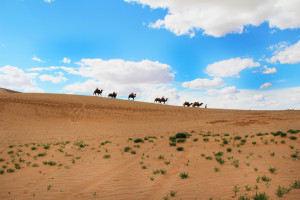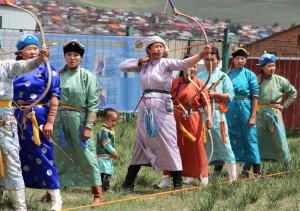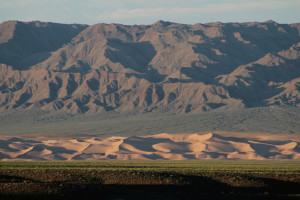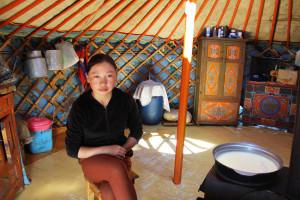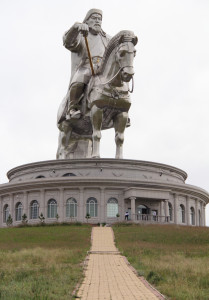Our caravan of four Mitsubishi vans raced across the low arid brush of the Gobi desert on another day of endless blue skies. Each van had found its groove, so to speak, in parallel tire tracks of hardened dirt and we were racing for the lead. Our Mongolian driver, Tulgaa, short and round but as solid as any bodybuilder, focused with intense concentration to keep our van on course. We were speeding along the flat landscape of Mongolia’s great southern desert, now a UNESCO Biosphere Reserve.
Before us spread a broad horizon dotted with herds of grazing sheep and Bactrian camels, their two humps silhouetted against the sky. This was the Mongolia I had come to see. Vast, haunting and seemingly endless. A land of dinosaur skeletons, nomadic herders and majestic sand dunes. Where throat singers are pop stars and fermented mare’s milk is a delicacy. The final frontier for any adventure traveler.
It was July, the temperate weather just perfect for the beginning of Mongolia’s famous Naadam festival. A colorful mix of the Olympics and our Fourth of July , the festival is a grand display of national pride and sports competition. Its roots date back 2300 years to the nomad weddings and hunting extravaganzas of the Mongol Army. The opening ceremony features the pomp and circumstance you’d expect from such an ancient tradition: marches, music and speeches from soldiers, monks and athletes before the competitions begin.
It’s two days of what is called “The Three Games of Men”– wrestling, horse racing and archery. Families and tourists gather in the capital of Ulaan Baatar to watch the competitions in the city’s Central Stadium. But there are also smaller festivals throughout the countryside with a carnival atmosphere filled with color and local charm. Mongolians hold a special place in their heart for horse racing and during Naadam, young jockeys age 5-12 race their horses over open countryside for twenty miles, hopefully crossing the finish line to cheering crowds. Archery dates back to Ghengis Khan and the Mongol hordes, notorious for sweeping out of the steppe on horseback and firing arrows with uncanny accuracy. But it’s no longer only a man’s sport. Women have become strong archers and competitors, their aim so precise that they can break small clay cups with their arrows from 30 meters away.
An early morning flight from Ulaan Baatar lands us on the sand runway at Dalanzagad, the capital city of Omongov or the South Gobi, the hottest, driest, most desolate area of the immense Gobi desert. The area is famous for geological diversity, wildlife and dinosaurs. We had come to explore the Gobi Gurvan Saikan National Park, with landscapes so varied it includes dunes, ice rivers and stunning mountain vistas. We head for Eagle Valley (Yolyn Am), a dramatic desert canyon valley with a year round stream that is frozen well into July. A leisurely mile-long walk (or horse ride) along the stream, jumping from rock to rock gets us to what’s remaining of the frozen glacier-like stretch of ice wedged between the ragged rock walls. Bearded vultures circle above and cute mouse-like creatures called pikas run to hide in underground burrows. The park contains hundreds of bird species, plants and endangered wild camel, snow leopard and argali sheep. The small Nature Museum at the gate has a collection of dinosaur eggs and bones and stuffed animals of the area.
The Khongoryn Els (Khongor Sand Dune) is probably the most dramatic landscape in the Gobi and the most spectacular sand dunes in all of Mongolia. They are up to half a mile high, and 65 miles long, a breathtaking sight as the light plays off of them from sunrise to sunset. And breath taking it is, climbing to the top. It’s exhausting with every step forward followed by a backsliding of half a step. On a steep incline. But the views are worth it–whether you’re half way up (where I finally gave up) or from the sandy summit (reached by only one in our group).
Our excursion takes us deeper into the desert to Bayanzad, popularly known as The Flaming Cliffs. A red sand and rock canyon, it was the bottom of an ancient sea eighty million years ago. Once an oasis teeming with prehistoric animal life, it is now a graveyard of oddly shaped cliffs and rock formations leading down to a sandy bottom where dinosaur bones lay buried. It’s Mongolia’s very own Jurassic Park cemetery.
In the 1920’s, flamboyant American archeologist and explorer Roy Chapman Andrews discovered a large dinosaur fossil field here that held the first– and largest–cache of dinosaur eggs ever found. Over the next two years he unearthed over 100 dinosaurs including the skeleton of the original Velociraptor and Oviraptor. He left Mongolia with seventy camels laden with his paleontological findings. Legend has it that Hollywood’s famous Indiana Jones character was based on the wildly adventurous Andrews.
The Ongiin Khiid on the banks of the Ongiin river is another stop on the tourist loop through Mongolia. Formerly one of the largest monasteries in Mongolia, it was home to over a thousand monks when the complex was destroyed in the 1939 communist purges. Two hundred lamas were murdered and the rest were sent to Siberian labor camps. This monastery once had 28 temples on its gently sloping hill. Today, one small temple has been rebuilt and a small group of lamas have returned to study. The ger camp adjacent to the Ongi Temple, Secret of the Ongi Tourist Camp, is one of the most deluxe (if that term can be used for ger camps) in the country. The main building is log and stone, reminiscent of a grand Chinese temple. The gers have decorative curved wooden doors and, the main building offers a sauna and massage room where massages are available for very reasonable rates.
Our travel circuit takes us to Karakorum, once the capital and important stop along the Silk Road, attracting traders, dignitaries and skilled workers from across Asia and Europe. Forty years later it was abandoned and destroyed. But what rose from its ruins in the 16th century was Erdene zuu, the oldest Buddhist monastery in Mongolia. Inside its walls once stood 100 temples with one thousand monks in residence. Destroyed by the communists (a recurring theme), its 108 stupas are now restored and surround the original monastery grounds.
The Khustain National Park is our next stop to see the takhi, Mongolia’s famous wild horse. Once almost extinct, conservationists dedicated themselves to breeding the animals in zoos in Europe while the suspicious communist government ruled Mongolia. Once democracy arrived, the horses were reintroduced. Today there are over 250 in the national park, a testament to international cooperation.
Our circuit of Mongolia is almost complete as we reach the Terelj National Park, just outside Ulaan Bataar. A playground for urban city folk, the area is cool and the scenery is alpine. We are here to tour the Gandam Monastery, the only monastery that survived the Stalinist purges. Manchurian influenced, it stands at the top of a hill with beautiful views that resemble Switzerland. A final stop after leaving the park is to the enormous Chinggis Khaan Statue, a stainless steel testament to the might and power of Mongolia’s brilliant but fearless leader that rises 131 feet above its base, looking out at the countryside.
What makes a trip to Mongolia memorable? A cultural night where Mongolian throat singers mesmerize you with sounds you’ve never heard before; sleeping in a decorative ger, a round tent-like structure with a wood lattice frame covered in thick felt and a heavy white canvas, every night toasty and comfortable; or the nomadic family who opened their doors and welcomed us in to their solar powered ger with traditional hospitality, graciously offering us fermented mare’s milk and aaruul (dried milk curds). The luxurious cashmere for sale? The endless horizons and brilliant blue skies? Or knowing that in a country of less than three million people, the literacy rate is 98% and 85% of the people vote in democratic elections? It’s all unforgettable and a once in a lifetime experience. But be forewarned! Travel in Mongolia is slow and tough. With only a few hundred miles of paved roads, the average speed is 30mph on interminably dusty tracks, cow paths and dried stream beds. Distances are great and much time is spent inside a van, bumping along for hours.
For all its long history, Mongolia is a very young country. When the Soviet government collapsed in 1990, it left Mongolia to fend for itself. The country has embraced Western-style democracy, a brave move considering their neighbors are China and Russia. Mongolia will hopefully preserve an ancient and rare way of life and merge it with the future. With mining in the south Gobi pouring money in to its economy, Mongolia is open for business and the time to see it is now.
Flo Tours will host a 15-day FAM to Mongolia in July 2015, staying in luxury hotels and ger camps. They will be offering ten-day trips through their Mongolian partner, Juulchin tours. Juulchin owns the luxury Kempinski Hotel in Ulaan Baatar and other businesses throughout the country. The tours will include luxury accommodations in the Kempinski Hotel in the capital city, the Terlj Hotel, HS Khaan Luxury Resort and the Three Camel Lodge in the Gobi. Prices start at $3900pp.
Flo Tours, www.flotours.com


